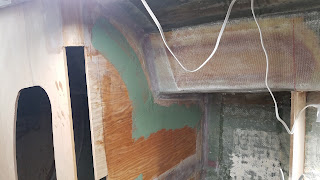I kept my promise and rigged a simple method to safe the ladder. It's just an angled piece of white ash I had laying around, screwed to the ladder with another screw sticking down as a pin. That pin sits in a drilled out hole in the 2x4 screwed to the companionway counter bulkhead. The ladder is now easily removed and replaced and secure to use. It took all of 15 minutes. Because that's usually how much effort it takes to avoid most of the stupid, dangerous, careless things I've done in life.
I tabbed some of the galley lockers. Molly came over to help for a few hours and it was the height of luxury to have someone else mix up the fillet material and wet out the glass tape. There were moments where I was even kinda doing nothin'. Such an easy pace made me feel a little lost. But I could get used to it.
I also tried out Total Boat's two-part fairing compound, Total Fair. It mixed easily enough with its yellow and blue components turning into a dull, even green when combined. The thixotropic viscosity is greater than drywall mud, but spreads easily, if slower, with no pinholes. I think I like it. I haven't sanded it yet, but reviews are generally good. The smell, however, is unpleasant. It reminds me of cheep rubber, um, adult-novelty toys from the 1990s. I don't mind the memories, but the odor is too chemical. Both then and now.
Finally, I noticed this vine climbing up the keel; the boat's been on the hard way too long.



























